Balancing a healthy diet and a consistent exercise routine can often feel like a complicated equation, but successful healthy living is truly about synergy, not sacrifice. The key to long-term,
Step Ahead of Shin Splints
September 1, 2023 2:27 pm / Category: Rausch Physical Therapy

Are you an avid runner, dancer, or sports enthusiast who’s been dealing with the frustrating discomfort of shin splints? Don’t worry, you’re not alone. These pesky pains can put a real damper on your active lifestyle. But fear not – we’re here to offer some friendly guidance on how to tackle those shin splints head-on and get back to doing what you love.
What are shin splints?
Shin splints refer to pain and tenderness along or just behind the large bone in the lower leg (the tibia).
What causes shin splints?
Shin splints most often happen after hard exercise, sports, or repetitive activity. This repetitive action can lead to inflammation of the muscles, tendons, and thin layer of tissue covering the shin bones, causing pain.
What are the symptoms of shin splints?
These are the most common symptoms of shin splints:
- Pain felt on the front and outside of the shin. It’s first felt when the heel touches the ground during running. In time, pain becomes constant and the shin is painful to the touch.
- Pain that starts on the inside of the lower leg above the ankle. Pain gets worse when standing on the toes or rolling the ankle inward. As the shin splint progresses, the pain will increase.
The symptoms of shin splints may look like other conditions or medical problems. Always talk with your healthcare provider for a diagnosis.
How are shin splints diagnosed?
Your healthcare provider can most often diagnose shin splints by reviewing your medical history and doing a physical exam. X-rays are often needed.
How are shin splints treated?
Your healthcare provider will figure out the best treatment based on:
- How old you are
- Your overall health and medical history
- How sick you are
- How well you can handle specific medicines, procedures, or therapies
- How long the condition is expected to last
- Your opinion or preference
The best course of treatment for shin splints is to stop any activity that’s causing the pain until the injury is healed. Other treatment may include:
- Stretching exercises
- Strengthening exercises
- Cold packs
- Medicine, such as ibuprofen
- Running shoes with a stiff heel and special arch support
Can shin splints be prevented?
You may be able to prevent shin splints by wearing good fitting athletic shoes. Also, gradually increase the intensity, duration, and frequency of a new exercise routine. It may also help to switch between high impact activities and low impact activities such as swimming or cycling.
Say goodbye to those bothersome shin splints and welcome pain-free activities! Our team of skilled physical therapists is here to help you regain your stride. Contact us today at 949-597-0007 to schedule your consultation. For more helpful tips and information, follow us on Instagram.
Reference: [https://www.hopkinsmedicine.org/health/conditions-and-diseases/shin-splints]






